Creating the perfect outdoor living space starts with choosing the right patio flooring. Modern patio flooring options blend functionality with aesthetic appeal, offering solutions for every style preference and budget. From eco-friendly materials to high-tech composites, today's patio flooring choices provide durability, low maintenance, and stunning visual impact. Whether you're designing a contemporary entertaining space or a rustic garden retreat, the right flooring serves as the foundation for your outdoor sanctuary. Current trends emphasize seamless indoor-outdoor transitions, mixed materials, and sustainable choices that withstand weather while enhancing your home's value and livability.
1. Stamped Concrete Patio Flooring
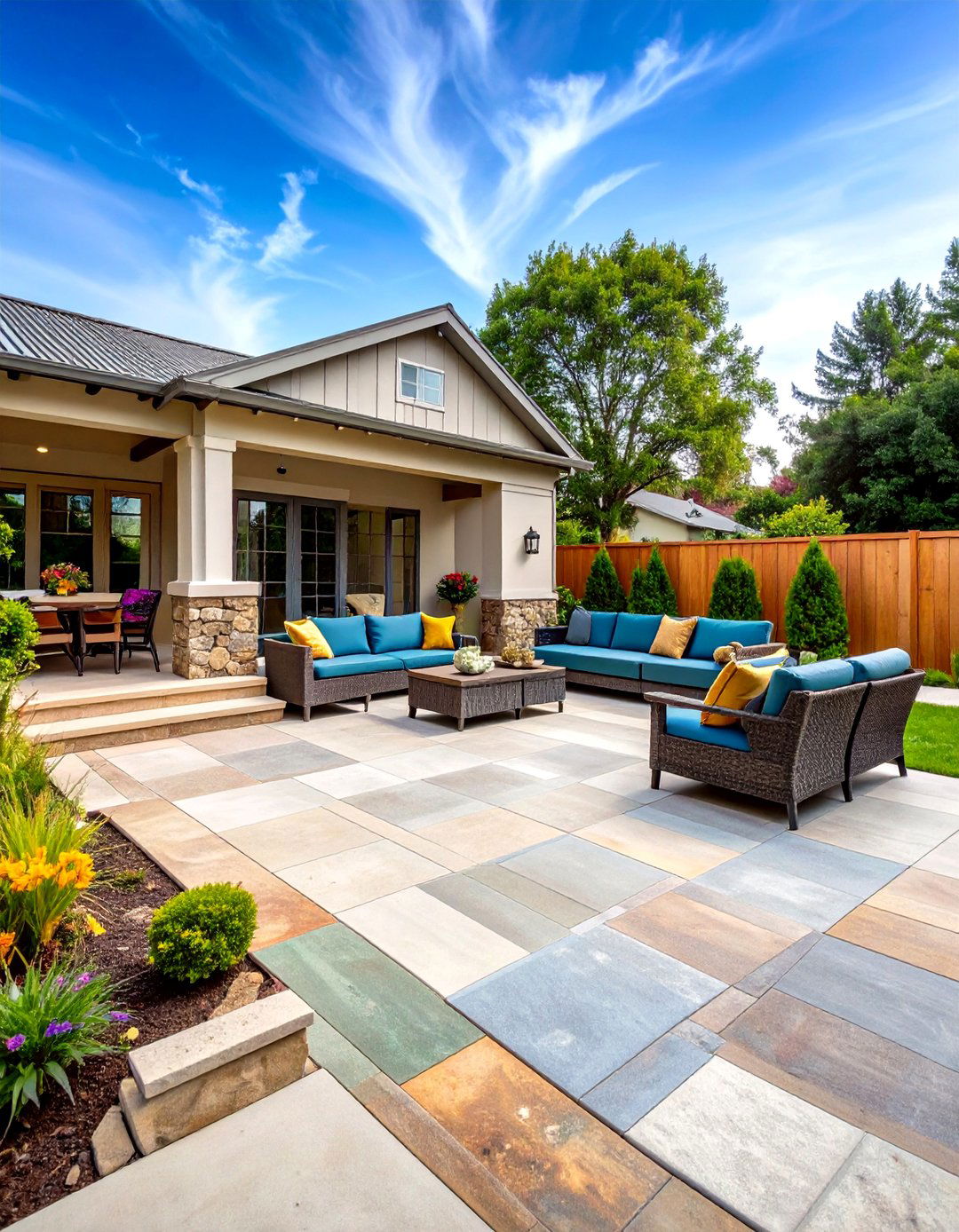
Stamped concrete patio flooring transforms ordinary concrete into stunning surfaces that mimic natural stone, brick, or wood. This versatile option uses specialized stamps and coloring techniques to create realistic textures and patterns at a fraction of the cost of premium materials. Popular patterns include ashlar slate, flagstone, and cobblestone designs, each offering unique visual appeal. The stamping process involves pressing textured molds into fresh concrete, followed by integral color and antiquing stains for authentic appearance. Stamped concrete patios provide excellent durability, lasting decades with minimal maintenance. They resist cracking better than plain concrete and can incorporate decorative borders or medallions for personalized touches.
2. Natural Stone Patio Flooring

Natural stone patio flooring delivers timeless elegance with materials like travertine, limestone, and slate. Each stone type offers distinct characteristics: travertine provides cool-to-touch comfort perfect for pool areas, limestone offers durability with subtle earth tones, and slate presents rich textures with natural slip-resistance. These materials age beautifully, developing unique patinas over time while maintaining structural integrity. Installation typically involves dry-set or mortar-bed methods, depending on stone type and climate conditions. Natural stone patios require periodic sealing to prevent staining and weather damage, but their inherent beauty and longevity make them worthwhile investments. The irregular shapes and natural variations create organic, sophisticated outdoor spaces that complement any architectural style.
3. Paver Patio Flooring
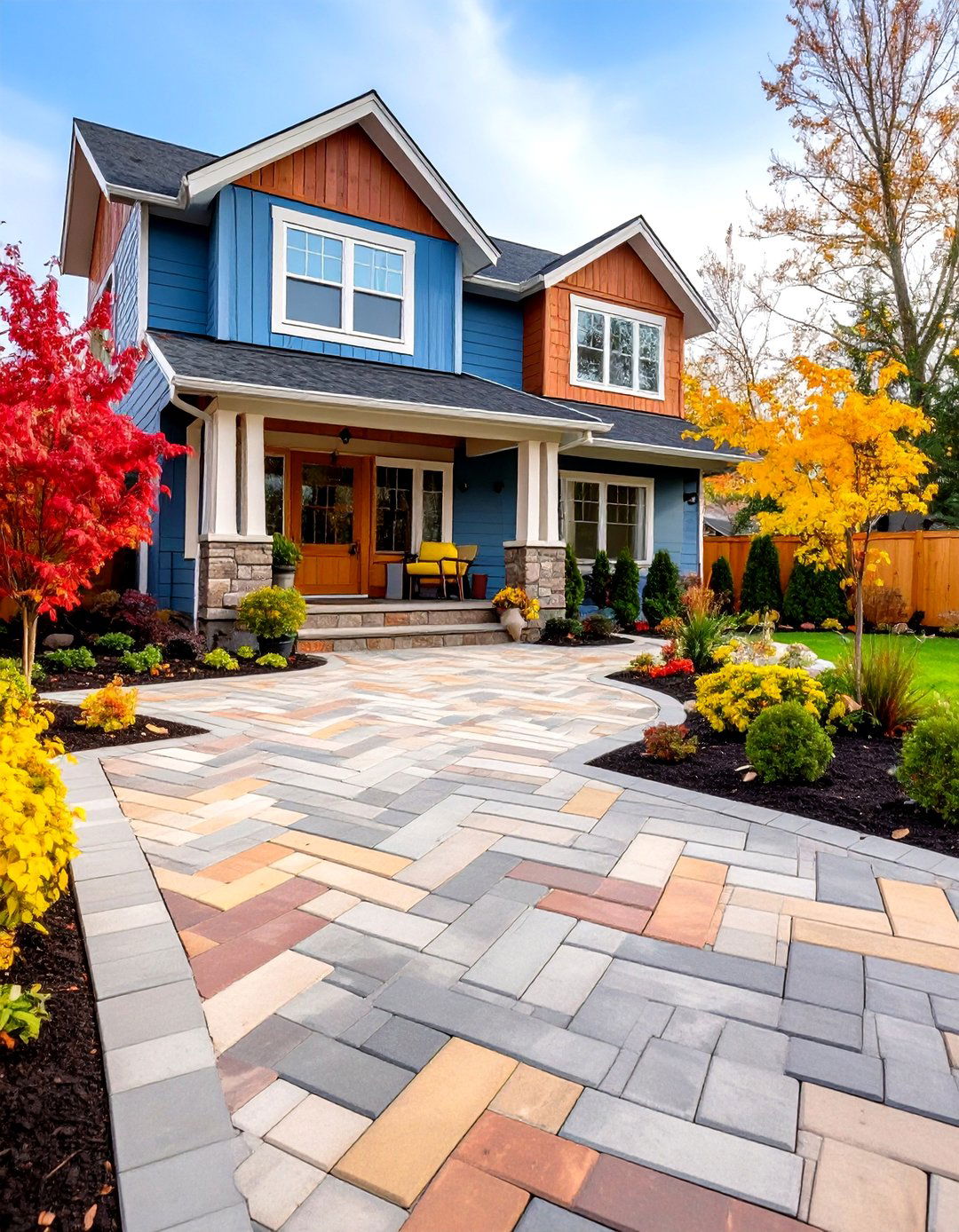
Paver patio flooring combines durability with design flexibility through interlocking concrete or clay units. These modular systems offer endless pattern possibilities, from classic running bond to intricate herringbone designs. Concrete pavers provide consistency and wide color selections, while clay pavers offer rich, natural hues that intensify with age. The interlocking design distributes weight evenly, preventing cracking and allowing for ground movement. Individual pavers can be easily replaced if damaged, making maintenance straightforward. Permeable paver options help manage stormwater runoff while providing stable surfaces. Installation involves careful base preparation with compacted gravel and sand leveling, ensuring long-term stability and proper drainage throughout the patio system.
4. Composite Patio Flooring
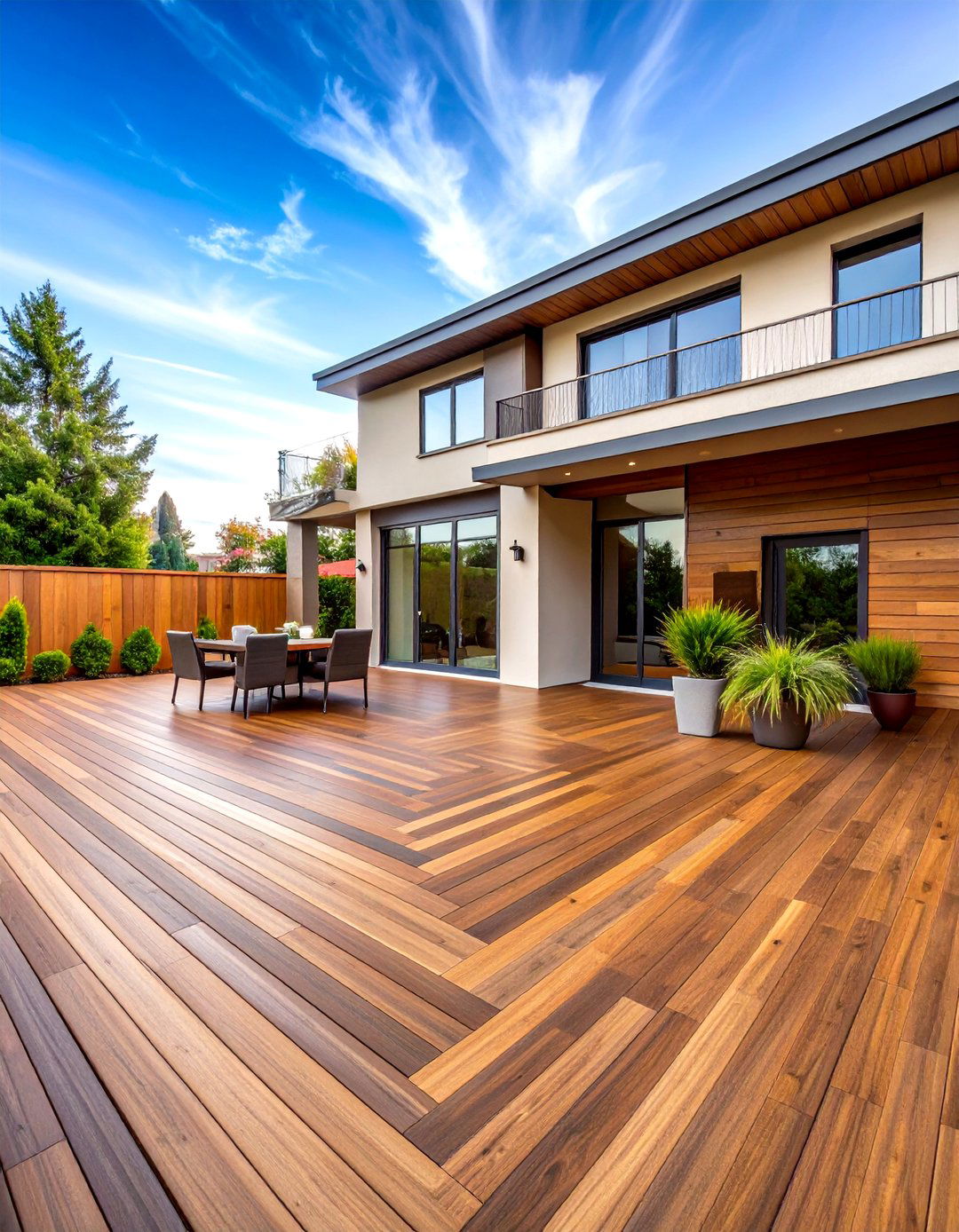
Composite patio flooring combines recycled wood fibers with plastic polymers, creating sustainable surfaces that resist moisture, insects, and UV damage. Unlike traditional wood, composite materials never require staining, sealing, or annual maintenance while maintaining natural wood appearance. Available in deck tiles or planks, composite flooring installs easily over existing concrete or prepared bases. Modern composite options feature realistic grain patterns and rich colors that won't fade or splinter. The material stays cooler than traditional decking in direct sunlight and provides slip-resistant surfaces when wet. Fire-resistant properties make composite flooring safer than wood alternatives, while its recycled content appeals to environmentally conscious homeowners seeking low-maintenance outdoor solutions.
5. Porcelain Tile Patio Flooring

Porcelain tile patio flooring offers superior strength and stain resistance with endless design possibilities. These dense, non-porous tiles withstand freeze-thaw cycles and heavy foot traffic while maintaining their appearance. Modern porcelain tiles convincingly replicate natural stone, wood, and fabric textures through advanced printing technologies. Large-format tiles create seamless looks with fewer grout lines, while smaller tiles allow for intricate patterns and color combinations. The material's low water absorption rate prevents mold and mildew growth, making it ideal for humid climates. Installation requires skilled professionals for proper alignment and grouting, but the results provide decades of beauty. Porcelain tiles clean easily with standard household cleaners and resist fading from UV exposure.
6. Rubber Patio Flooring
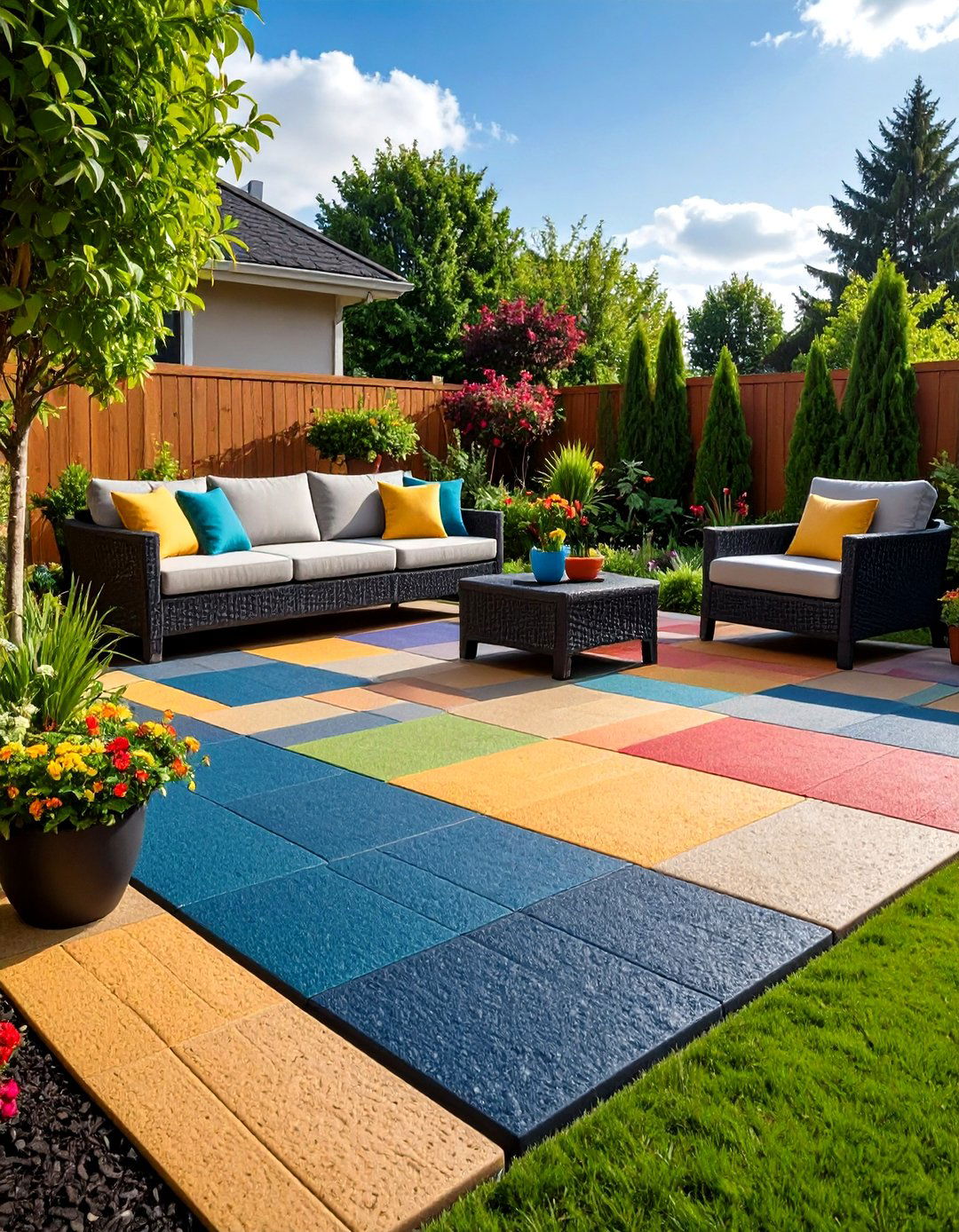
Rubber patio flooring provides safe, comfortable surfaces ideal for family-friendly outdoor spaces. Made from recycled tires or synthetic materials, rubber flooring offers excellent slip resistance and shock absorption. The material stays cool in hot weather and provides cushioning for children's play areas. Rubber pavers or tiles install easily over existing surfaces, creating quick patio transformations. The material resists weather extremes, chemicals, and staining while maintaining flexibility that prevents cracking. Available in various colors and textures, rubber flooring complements both modern and traditional design schemes. Maintenance involves simple sweeping and occasional washing with mild soap. The eco-friendly nature of recycled rubber appeals to environmentally conscious homeowners while providing practical benefits for active families.
7. Pea Gravel Patio Flooring
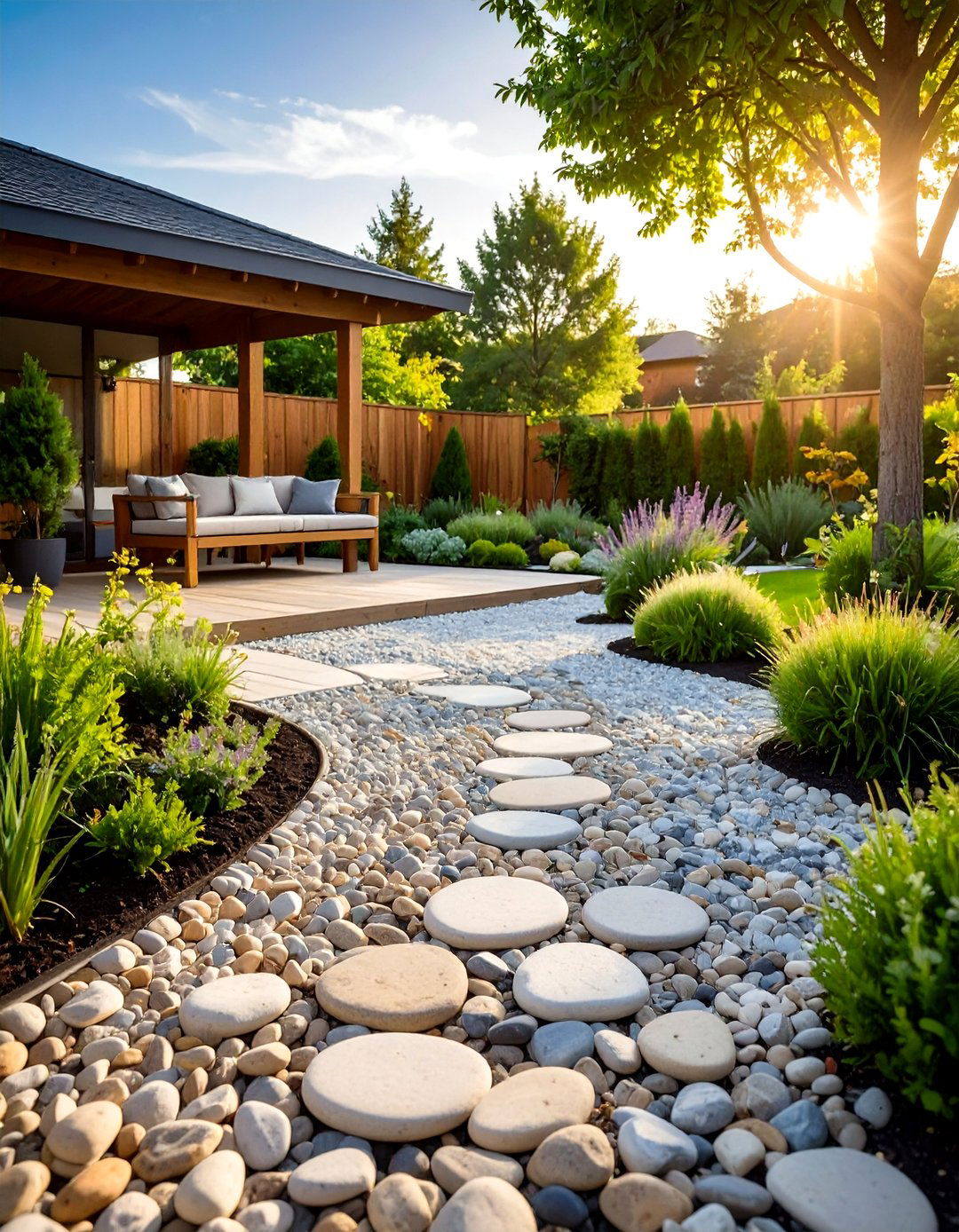
Pea gravel patio flooring creates charming, cottage-style outdoor spaces with natural drainage properties. These small, rounded stones provide excellent permeability while offering comfortable walking surfaces. The material's natural colors range from warm beiges to cool grays, blending seamlessly with landscaping. Installation involves edging definition and proper depth preparation, typically 2-3 inches for optimal stability. Pea gravel works well in informal settings and can be easily shaped around curves and obstacles. The material stays cool in hot weather and provides natural sound dampening. While maintenance involves occasional raking and edge redefinition, pea gravel offers affordability and natural beauty. Combining with stepping stones or pavers creates visual interest while providing firmer walking paths through gravel areas.
8. Artificial Turf Patio Flooring

Artificial turf patio flooring brings year-round greenery to outdoor spaces without maintenance requirements. Modern synthetic grass features realistic blade shapes, varied colors, and natural-feeling textures that closely mimic real grass. The material stays consistently green regardless of weather conditions, drought, or foot traffic. Installation over patios requires proper drainage underlayment and secure edging for professional appearance. Artificial turf provides comfortable, soft surfaces ideal for children and pets while eliminating allergens associated with natural grass. The material resists fading from UV exposure and withstands temperature extremes. Maintenance involves occasional brushing and rinsing, making it perfect for busy homeowners. Pet-friendly options include antimicrobial treatments and enhanced drainage systems for odor control and cleanliness.
9. Flagstone Patio Flooring
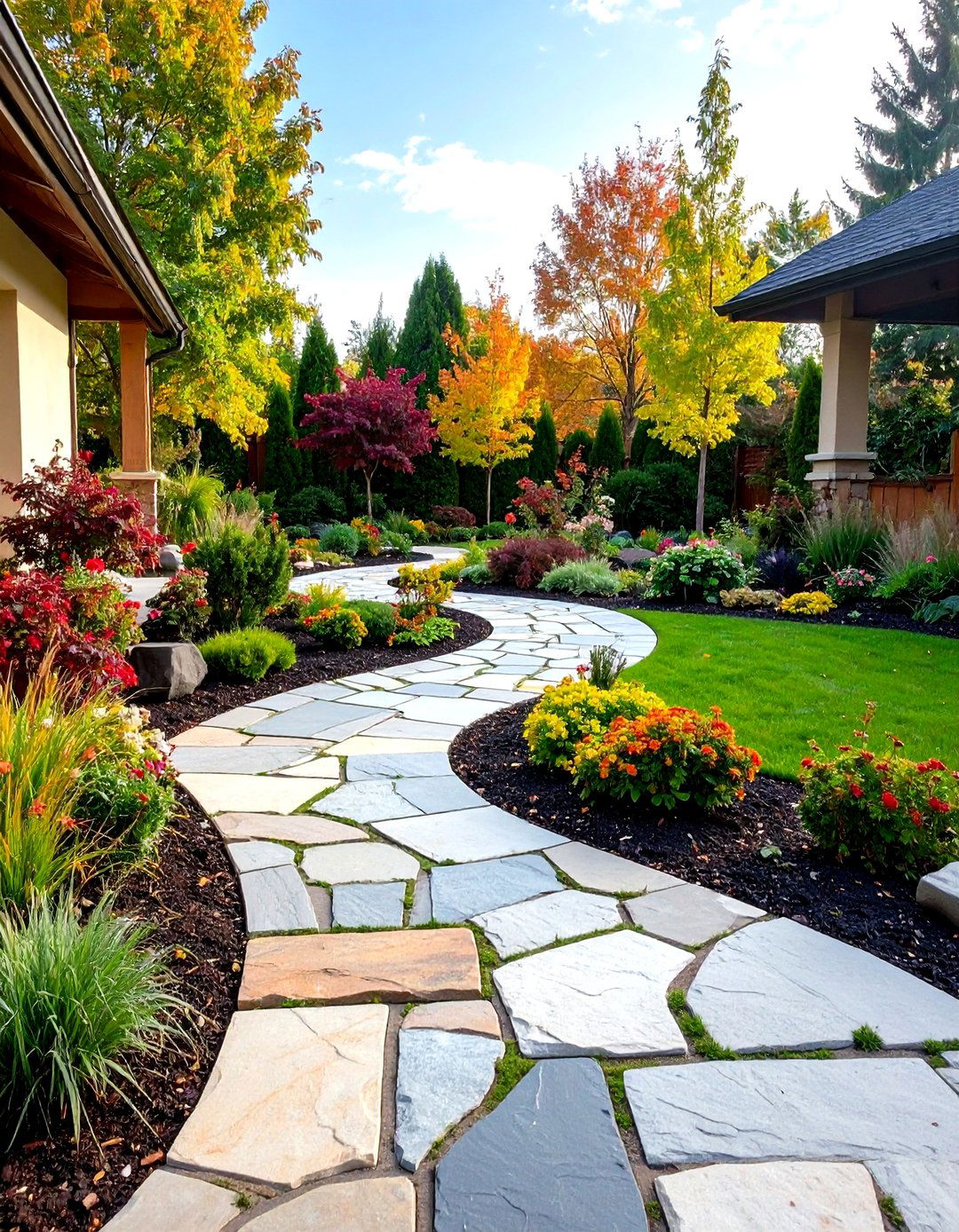
Flagstone patio flooring showcases natural stone's irregular beauty through flat, split-rock surfaces. Common varieties include bluestone, sandstone, and limestone, each offering unique colors and textures. The irregular shapes create organic patterns that complement natural landscapes and informal garden settings. Installation methods include dry-laid sand beds or mortared joints for formal appearances. Flagstone's natural cleft surface provides excellent slip resistance while developing attractive patinas over time. The material's thermal mass helps regulate temperature, staying cool in summer heat. Proper installation requires skilled craftsmanship for stable, long-lasting results. Flagstone patios work exceptionally well with native plantings and water features, creating seamless transitions between hardscape and landscape elements throughout outdoor living spaces.
10. Interlocking Tile Patio Flooring
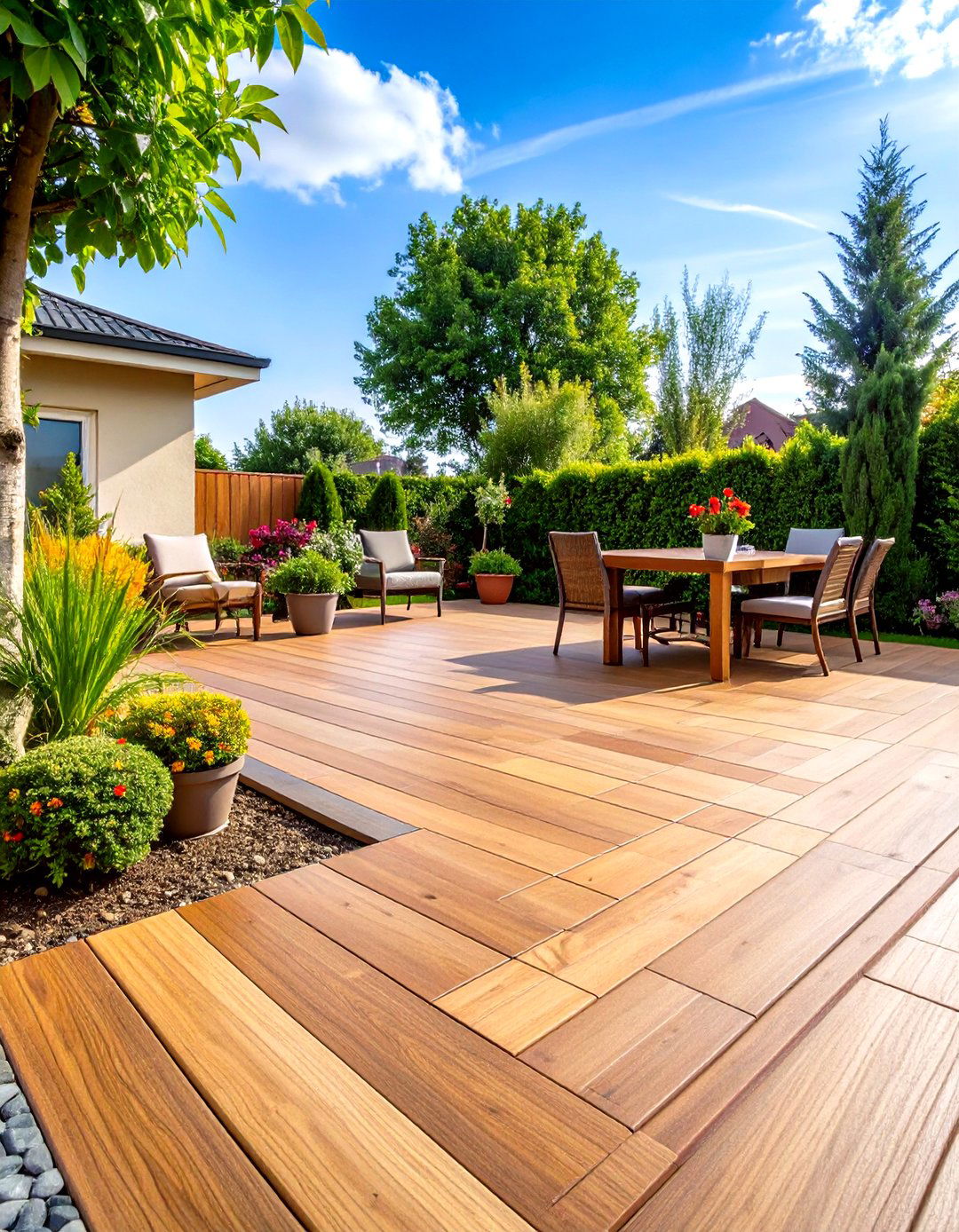
Interlocking tile patio flooring systems offer DIY-friendly installation with professional results. These modular units snap together without adhesives, creating stable surfaces over various substrates. Materials range from composite wood-look tiles to stone-textured options, accommodating different aesthetic preferences. The click-lock systems distribute weight evenly while allowing for thermal expansion and contraction. Individual tiles can be easily replaced if damaged, making long-term maintenance simple. Installation requires level surfaces but doesn't need specialized tools or professional expertise. The tiles provide excellent drainage through gaps between units while maintaining stable walking surfaces. This flooring type works well for temporary installations or rental properties where permanent solutions aren't practical. Various colors and patterns allow customization to match existing outdoor décor.
11. Ceramic Tile Patio Flooring
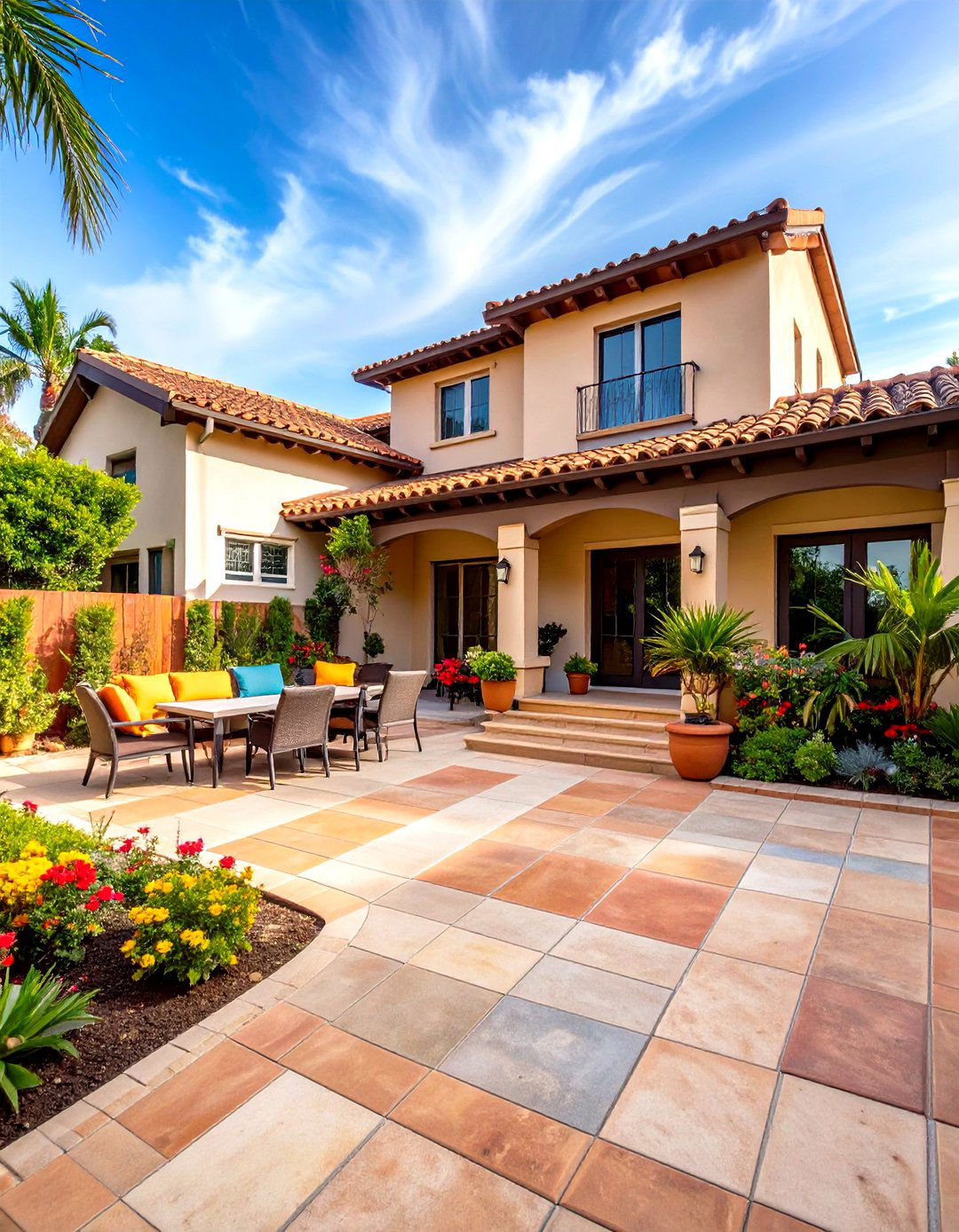
Ceramic tile patio flooring provides affordable elegance with extensive design options. These fired clay tiles offer durability and water resistance suitable for most climates. Surface treatments include textured finishes for slip resistance and glazed options for easy cleaning. Ceramic tiles accommodate various installation patterns, from simple grid layouts to complex geometric designs. The material's thermal properties help regulate surface temperatures while providing stable walking surfaces. Professional installation ensures proper drainage and prevents cracking from ground movement. Ceramic tiles require periodic sealing in freeze-thaw climates but generally maintain appearance with minimal maintenance. The wide range of colors, sizes, and textures allows coordination with indoor flooring for seamless indoor-outdoor transitions. Cost-effectiveness makes ceramic tiles attractive for larger patio areas.
12. Brick Patio Flooring
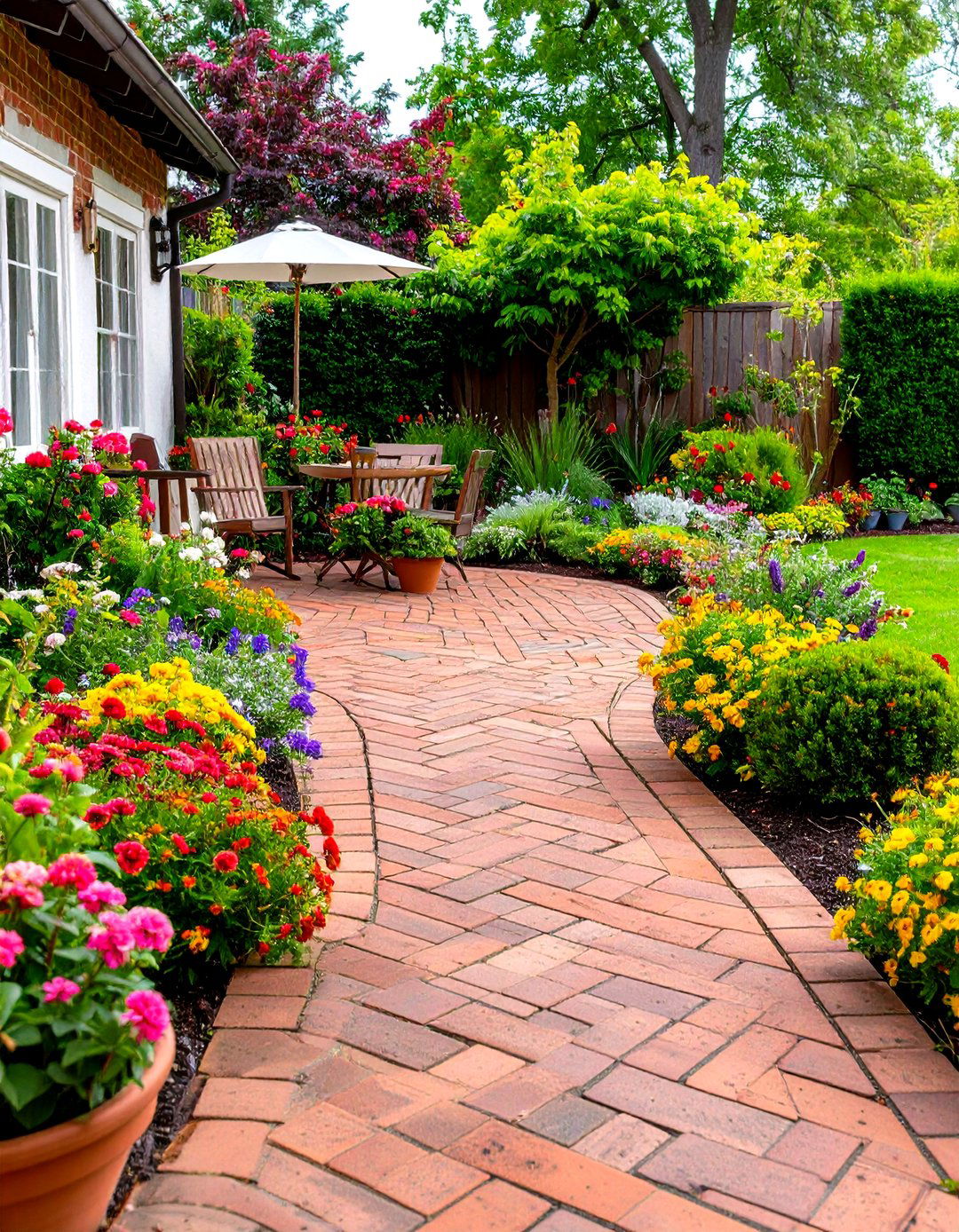
Brick patio flooring delivers classic charm with enduring appeal across architectural styles. Traditional clay bricks develop rich patinas over time while maintaining structural integrity. The material's uniform size enables various laying patterns, including herringbone, basket weave, and running bond designs. Brick provides excellent slip resistance and thermal mass for temperature regulation. Installation methods include sand-set and mortar-bed techniques, depending on desired formality and climate requirements. Reclaimed bricks offer historical character and sustainability benefits. The material's natural porosity allows for drainage while preventing water pooling. Brick patios complement garden settings and historical homes exceptionally well. Maintenance involves occasional re-sanding joints and replacing damaged units, but properly installed brick patios last generations with minimal care while gaining character through aging.
13. Granite Patio Flooring

Granite patio flooring represents the pinnacle of natural stone durability and elegance. This igneous rock withstands extreme weather conditions while maintaining polished appearance. Available in various textures from smooth honed to rough flamed finishes, granite accommodates different aesthetic preferences and slip-resistance requirements. The material's density provides excellent longevity and minimal maintenance needs. Colors range from classic grays to dramatic blacks and warm earth tones. Professional installation ensures proper support and drainage for this heavy material. Granite's non-porous nature resists staining and bacterial growth, making it ideal for outdoor dining areas. The material's natural beauty and prestige enhance property values while providing functional outdoor surfaces. Thermal properties keep surfaces comfortable in various weather conditions throughout the year.
14. Sandstone Patio Flooring
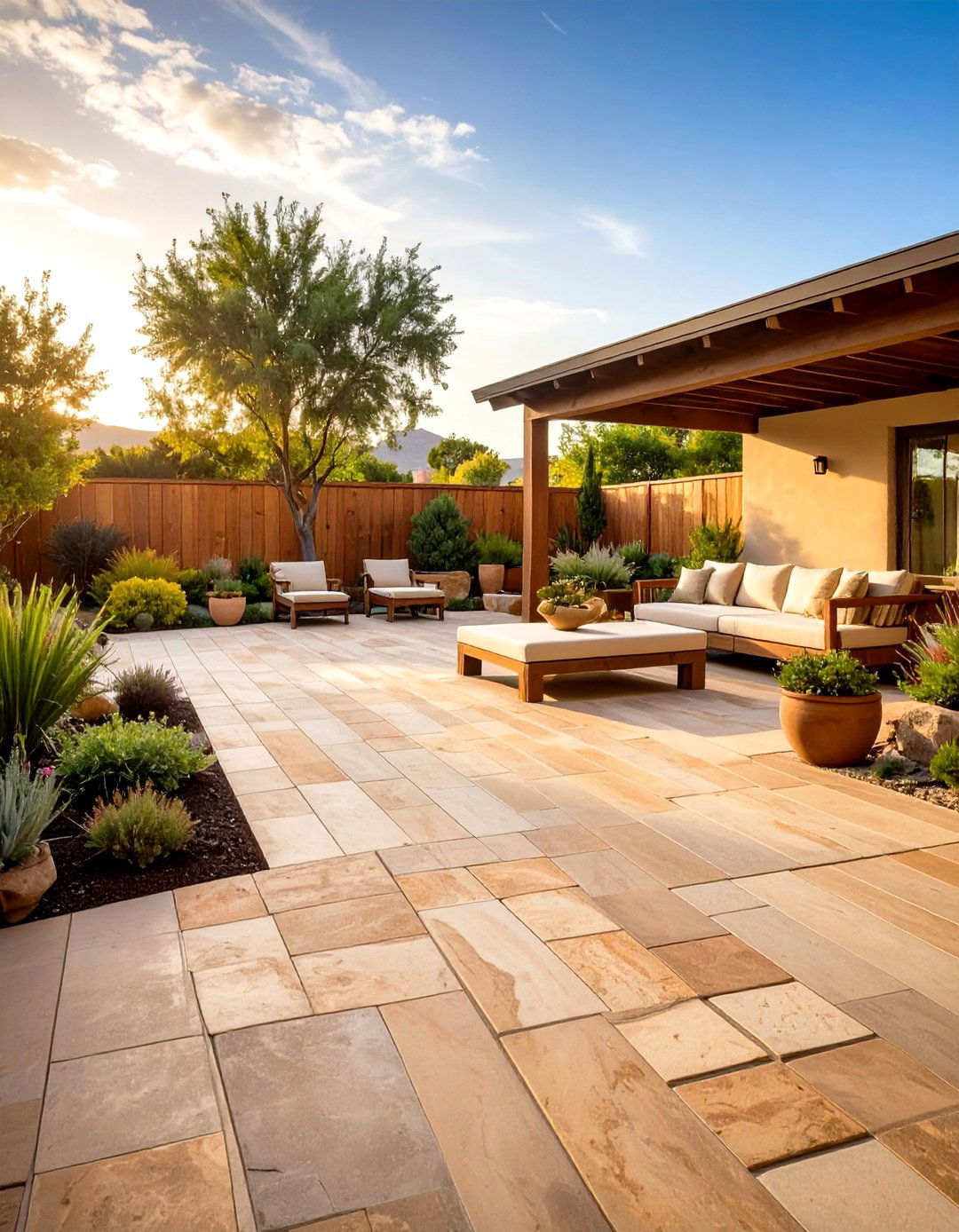
Sandstone patio flooring offers warm, earthy tones with naturally textured surfaces. This sedimentary rock provides excellent slip resistance through its inherent roughness while remaining comfortable underfoot. Available colors range from buff and tan to rich reds and browns, complementing natural landscapes beautifully. The material's porosity allows for drainage while requiring periodic sealing for stain protection. Sandstone works well in both formal and informal settings, adapting to various design styles. The stone's natural layering creates interesting visual textures and patterns. Installation involves careful selection and fitting of irregular pieces for optimal appearance. Sandstone's thermal properties provide comfortable surfaces that don't become excessively hot in direct sunlight. The material ages gracefully, developing attractive patinas that enhance outdoor spaces' natural character.
15. Cobblestone Patio Flooring

Cobblestone patio flooring creates distinctive, old-world charm with time-tested durability. These naturally rounded stones, traditionally sourced from riverbeds, provide excellent slip resistance and longevity. The irregular shapes and sizes create organic patterns that complement historical architecture and formal gardens. Installation requires skilled craftspeople for proper fitting and stability. Cobblestone's natural variations in color and texture create visually interesting surfaces that improve with age. The material's durability has been proven through centuries of use in streets and walkways. Modern cobblestone options include newly quarried stones and reclaimed materials from historical sites. The three-dimensional surface provides excellent drainage while creating distinctive walking experiences. Cobblestone patios work exceptionally well with traditional landscaping and period-appropriate architectural styles.
16. Stained Concrete Patio Flooring

Stained concrete patio flooring transforms basic concrete into artistic surfaces through color and texture enhancement. Acid stains penetrate concrete surfaces, creating permanent, variegated colors that won't fade or peel. Water-based stains offer broader color selections and consistent coverage. The staining process can create marble-like effects, earth tones, or bold contemporary colors. Surface preparation and application techniques significantly impact final appearance, requiring skilled professionals for optimal results. Stained concrete provides affordable luxury with minimal maintenance requirements. The material's durability and weather resistance make it ideal for outdoor applications. Decorative techniques include scoring patterns, adding aggregates, and combining with stamping for enhanced textures. Sealed surfaces resist staining and wear while maintaining vibrant colors throughout years of use.
17. Terrazzo Patio Flooring
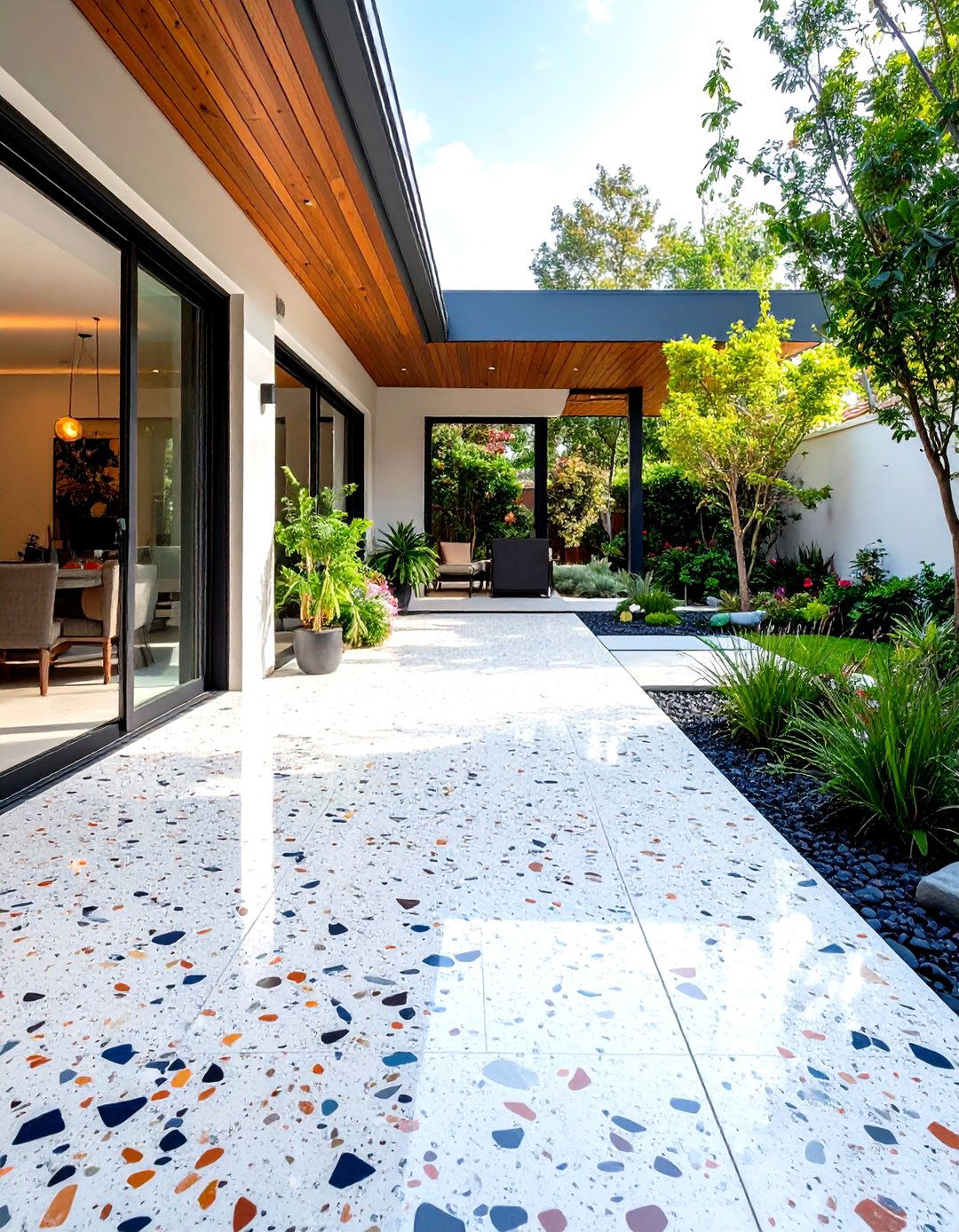
Terrazzo patio flooring combines marble chips with cement or epoxy binders, creating durable, decorative surfaces. This composite material offers unlimited design possibilities through chip selection and color combinations. Modern terrazzo systems use advanced binders that improve weather resistance and reduce maintenance requirements. The material's smooth surface cleans easily while providing slip resistance through textured finishes. Installation involves skilled craftspeople who can create custom patterns and designs. Terrazzo's durability makes it suitable for high-traffic areas while maintaining polished appearance. The material's thermal mass helps regulate surface temperatures throughout daily cycles. Sustainable options include recycled glass and stone content, appealing to environmentally conscious homeowners. Professional grinding and sealing create surfaces that last decades with minimal maintenance while providing unique, artistic outdoor flooring solutions.
18. Deck Tile Patio Flooring
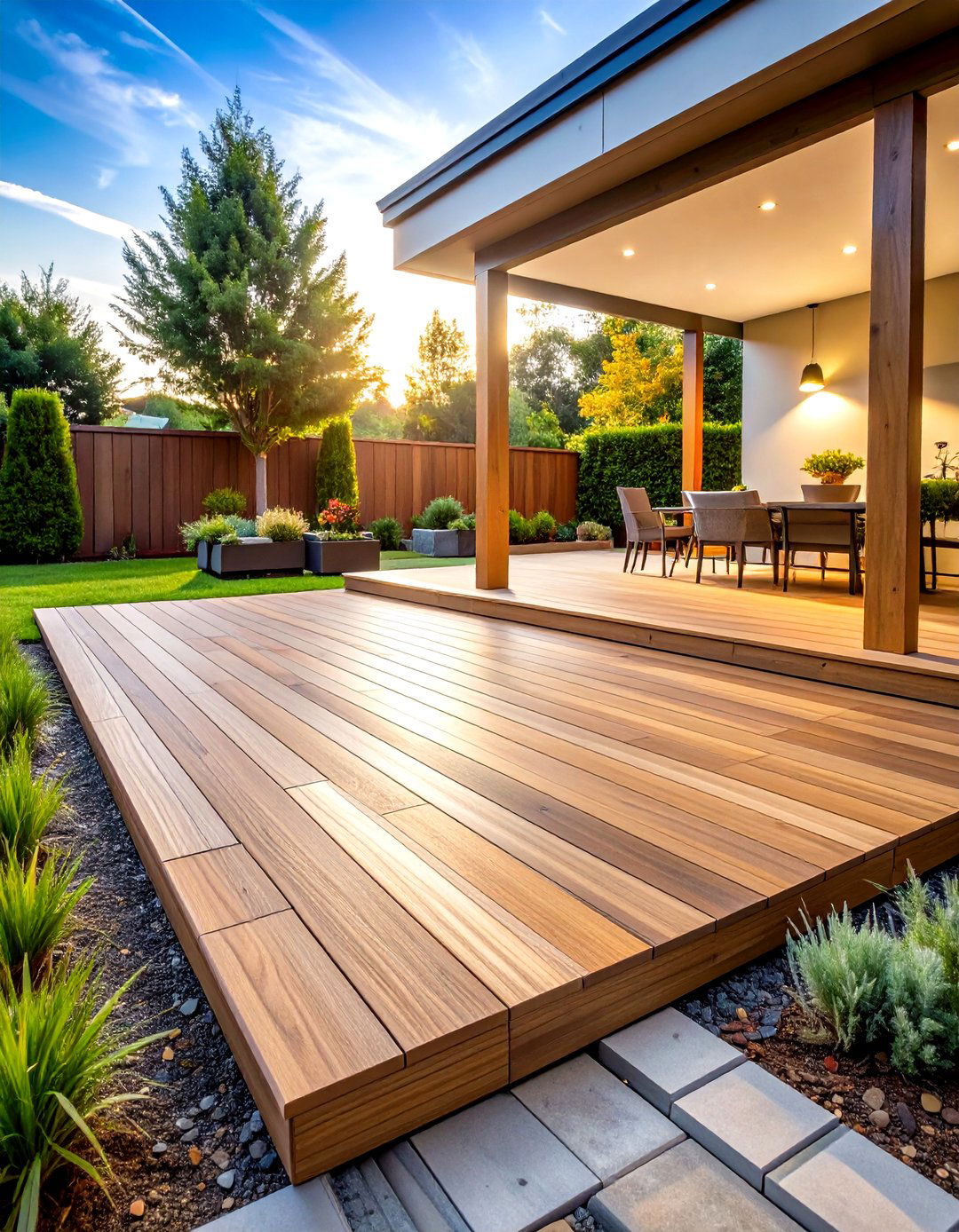
Deck tile patio flooring provides quick, affordable solutions for transforming outdoor spaces. These modular systems snap together without tools, creating stable surfaces over existing concrete or properly prepared bases. Materials include composite wood, natural wood, and synthetic options in various colors and textures. The tiles accommodate irregular spaces and can be easily removed for cleaning or relocation. Installation doesn't require professional expertise, making it ideal for DIY enthusiasts. The elevated design allows for drainage and air circulation, preventing moisture problems. Individual tiles can be replaced if damaged, extending overall system life. The tiles work well for rental properties or temporary installations. Various patterns and colors allow customization to match existing décor. Maintenance involves simple cleaning and occasional repositioning for optimal appearance.
19. Saltillo Tile Patio Flooring
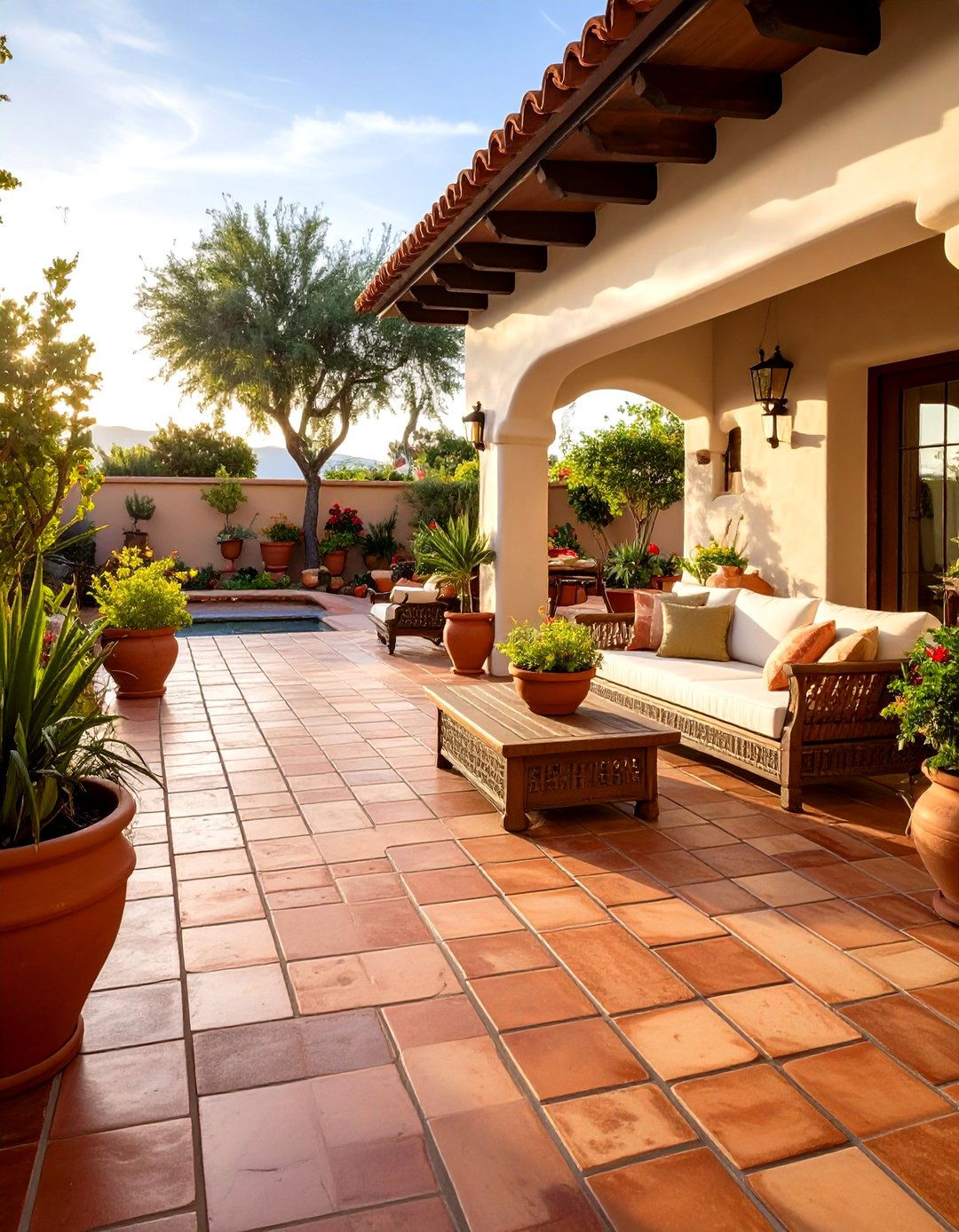
Saltillo tile patio flooring brings Mexican terra cotta charm to outdoor spaces with handcrafted character. These clay tiles offer warm, earthy colors that complement southwestern and Mediterranean architectural styles. The material's natural porosity requires sealing for weather protection but provides authentic appearance and feel. Handmade variations create unique patterns and textures that machine-made tiles cannot replicate. Installation involves traditional sand-set methods or modern mortar-bed techniques for durability. The tiles' thermal properties keep surfaces comfortable in various weather conditions. Natural aging develops attractive patinas that enhance outdoor spaces' character. Saltillo tiles work exceptionally well with rustic furnishings and natural landscaping. The material's affordability and distinctive appearance make it popular for covered patios and courtyards where weather protection extends tile life.
20. Quartzite Patio Flooring
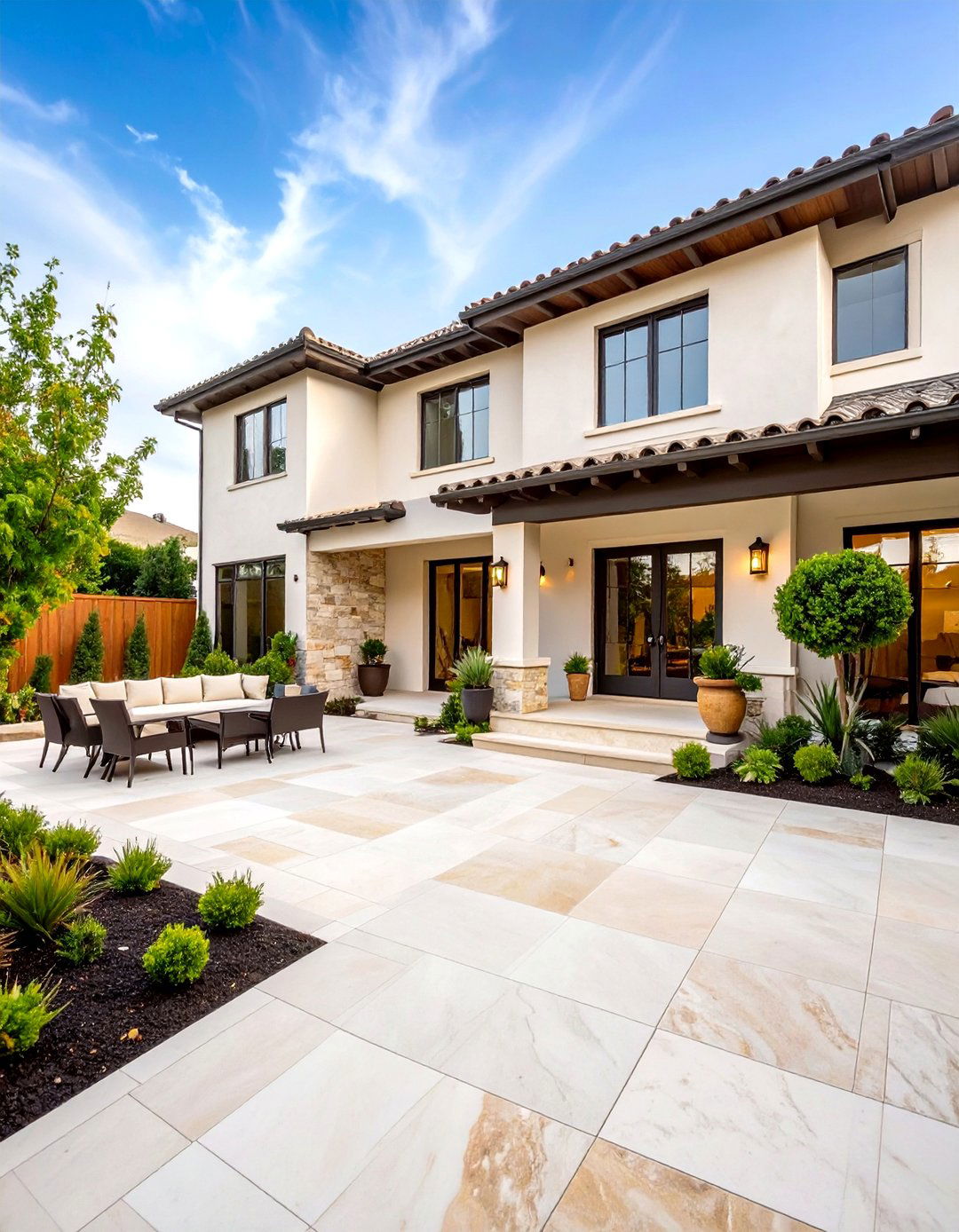
Quartzite patio flooring delivers exceptional durability with natural stone beauty. This metamorphic rock provides superior hardness and weather resistance compared to other natural stones. Available in various colors from whites and grays to rich golds and reds, quartzite complements diverse architectural styles. The material's density provides excellent longevity with minimal maintenance requirements. Surface textures range from smooth to rough, accommodating different aesthetic preferences and slip-resistance needs. Professional installation ensures proper support for this heavy material. Quartzite's non-porous nature resists staining and bacterial growth, making it ideal for outdoor dining areas. The material's natural beauty and prestige enhance property values while providing functional outdoor surfaces. Thermal properties keep surfaces comfortable while the stone's natural variations create visually interesting patterns throughout patio areas.
Conclusion:
Choosing the right patio flooring depends on your climate, budget, maintenance preferences, and design vision. Natural materials like stone and brick offer timeless beauty but require more maintenance, while synthetic options provide durability with minimal upkeep. Consider factors like slip resistance, thermal properties, and installation requirements when making your selection. Whether you prefer the elegance of natural stone, the affordability of concrete, or the convenience of composite materials, the right patio flooring creates an outdoor space that enhances your lifestyle and property value for years to come.



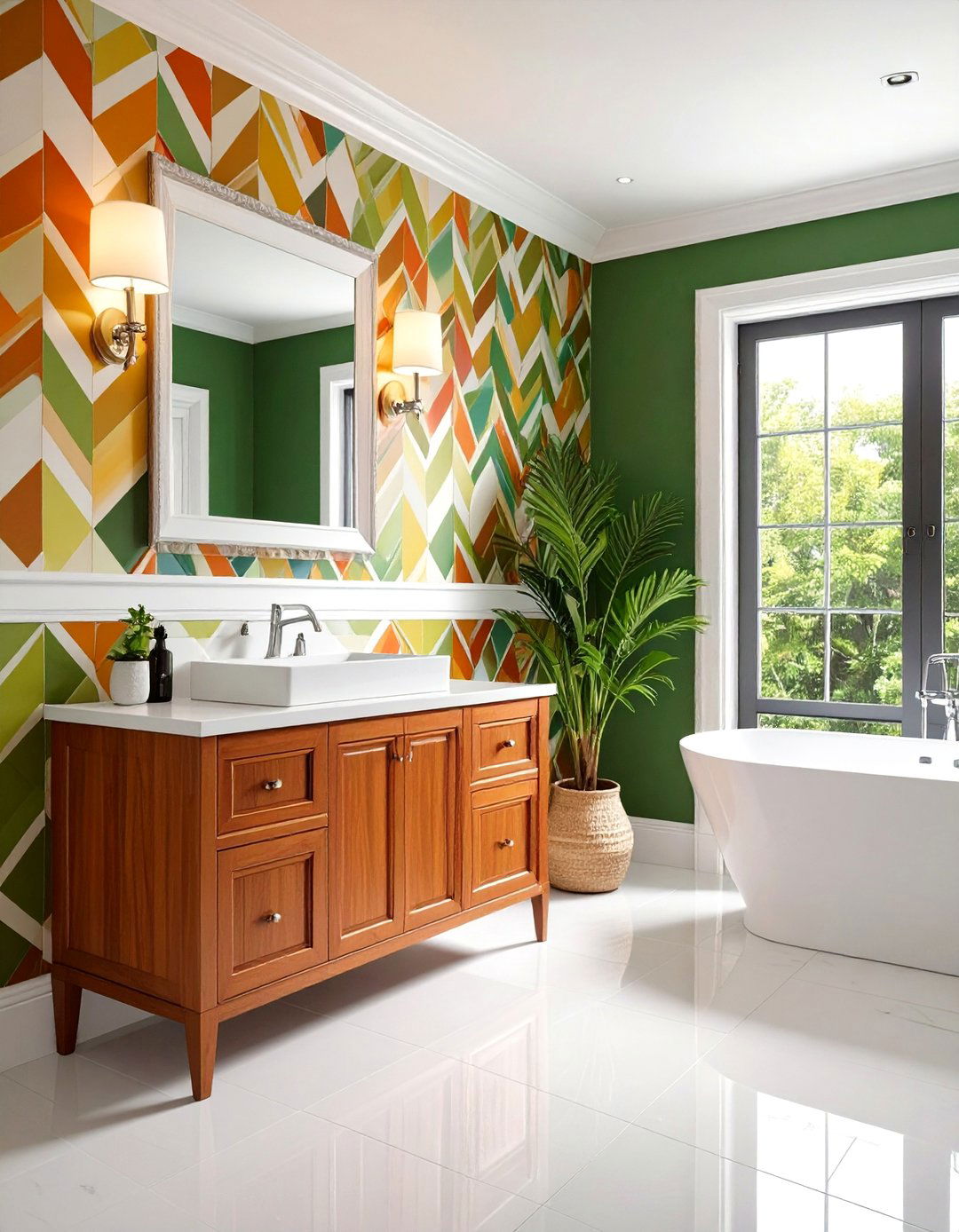

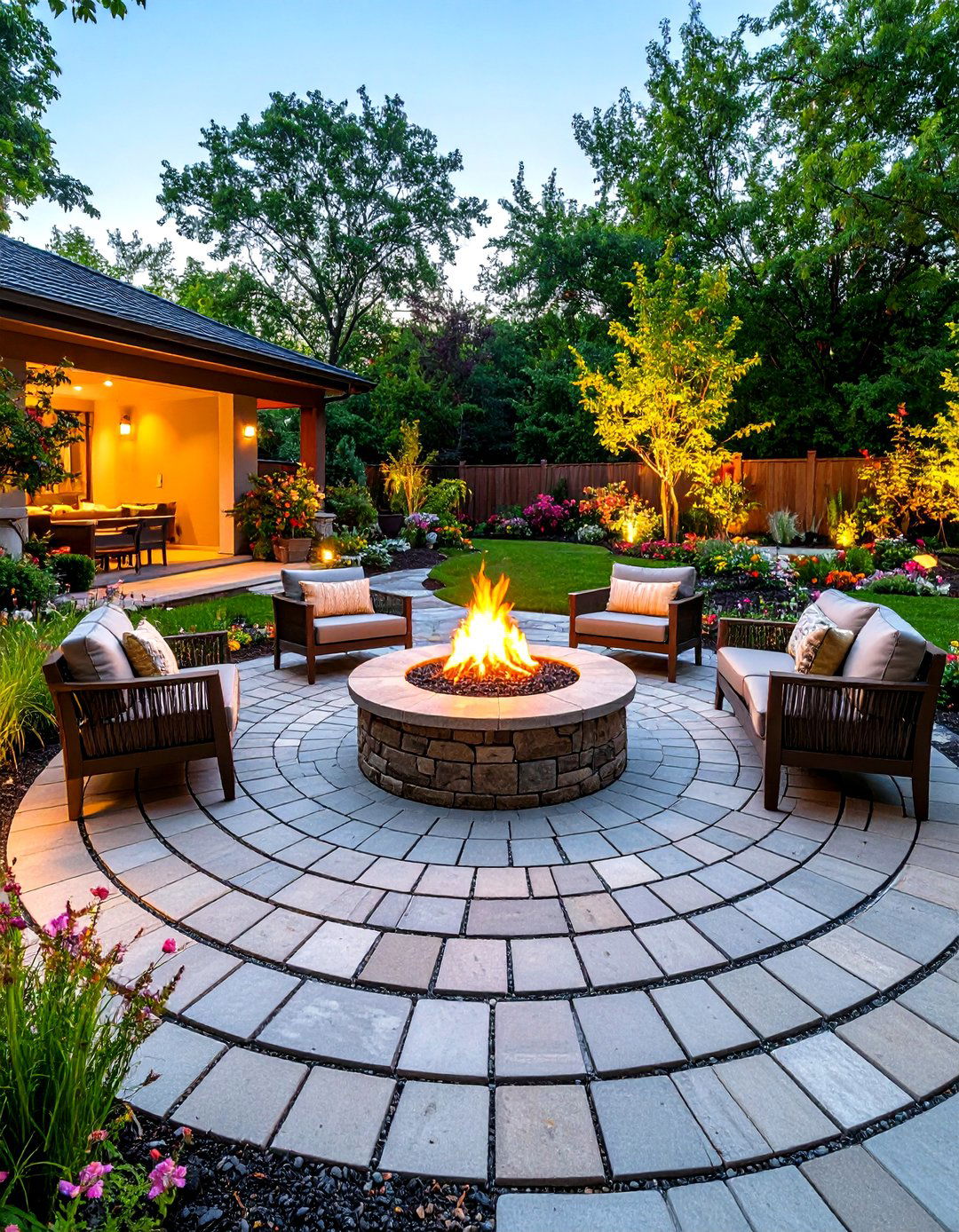
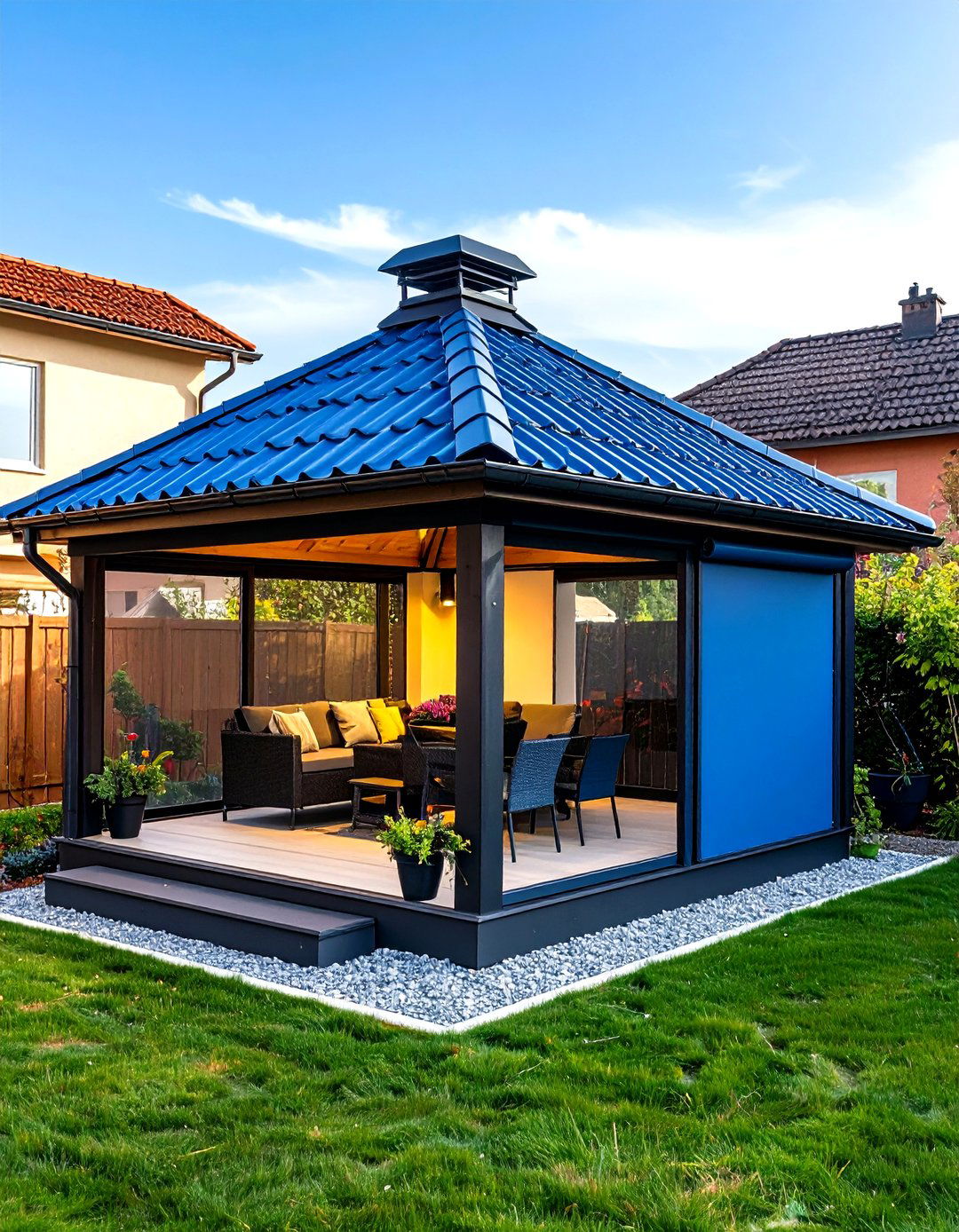
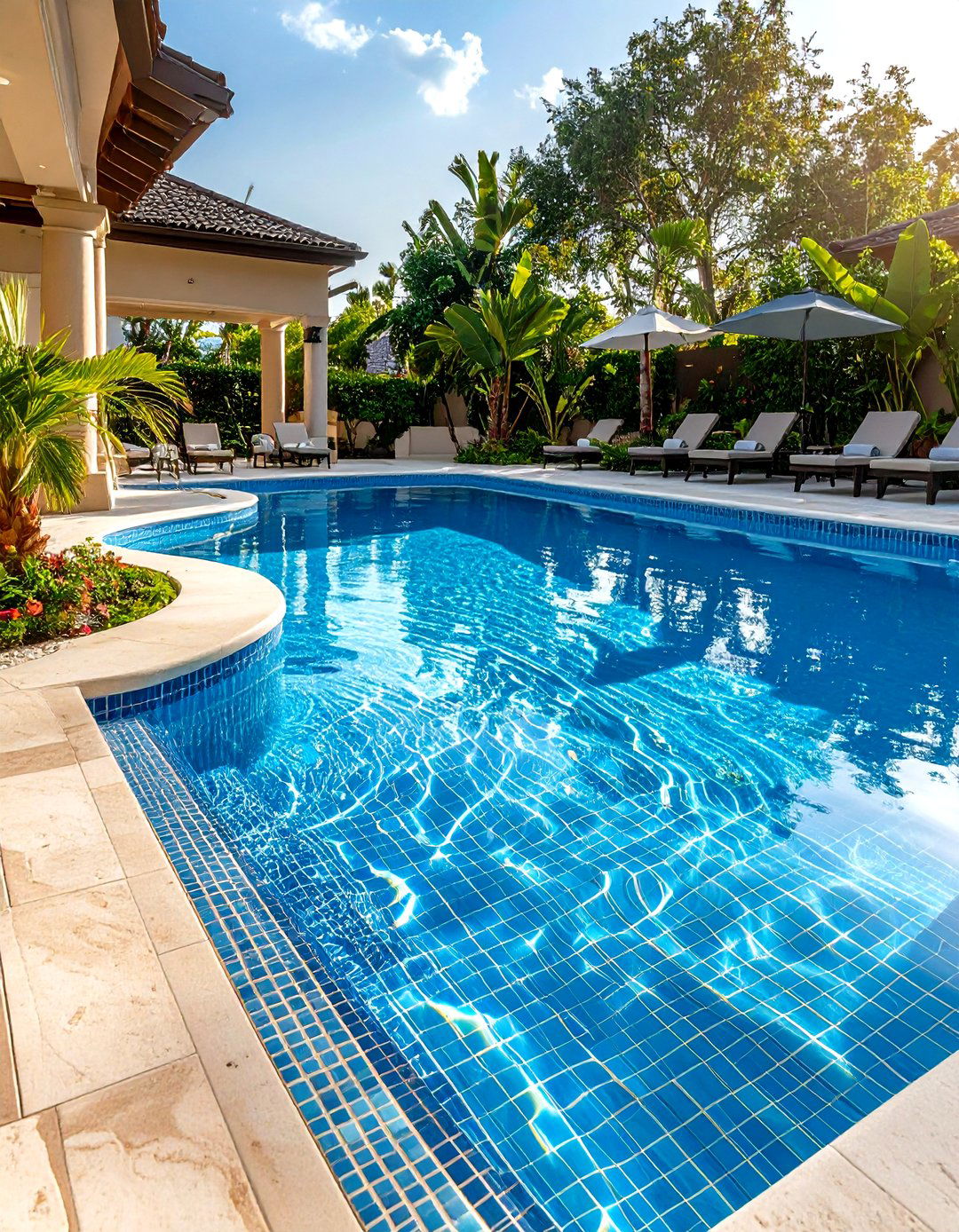
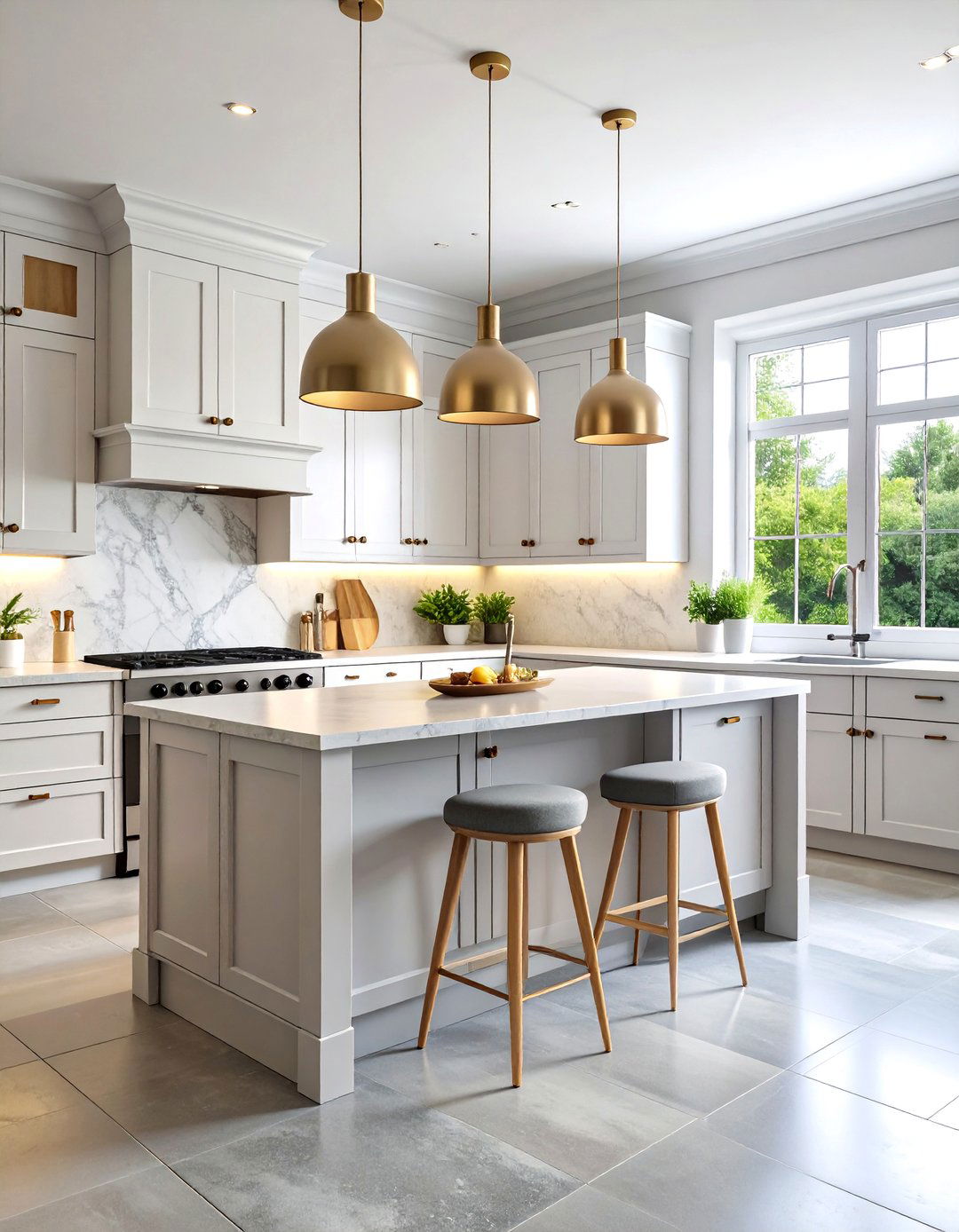
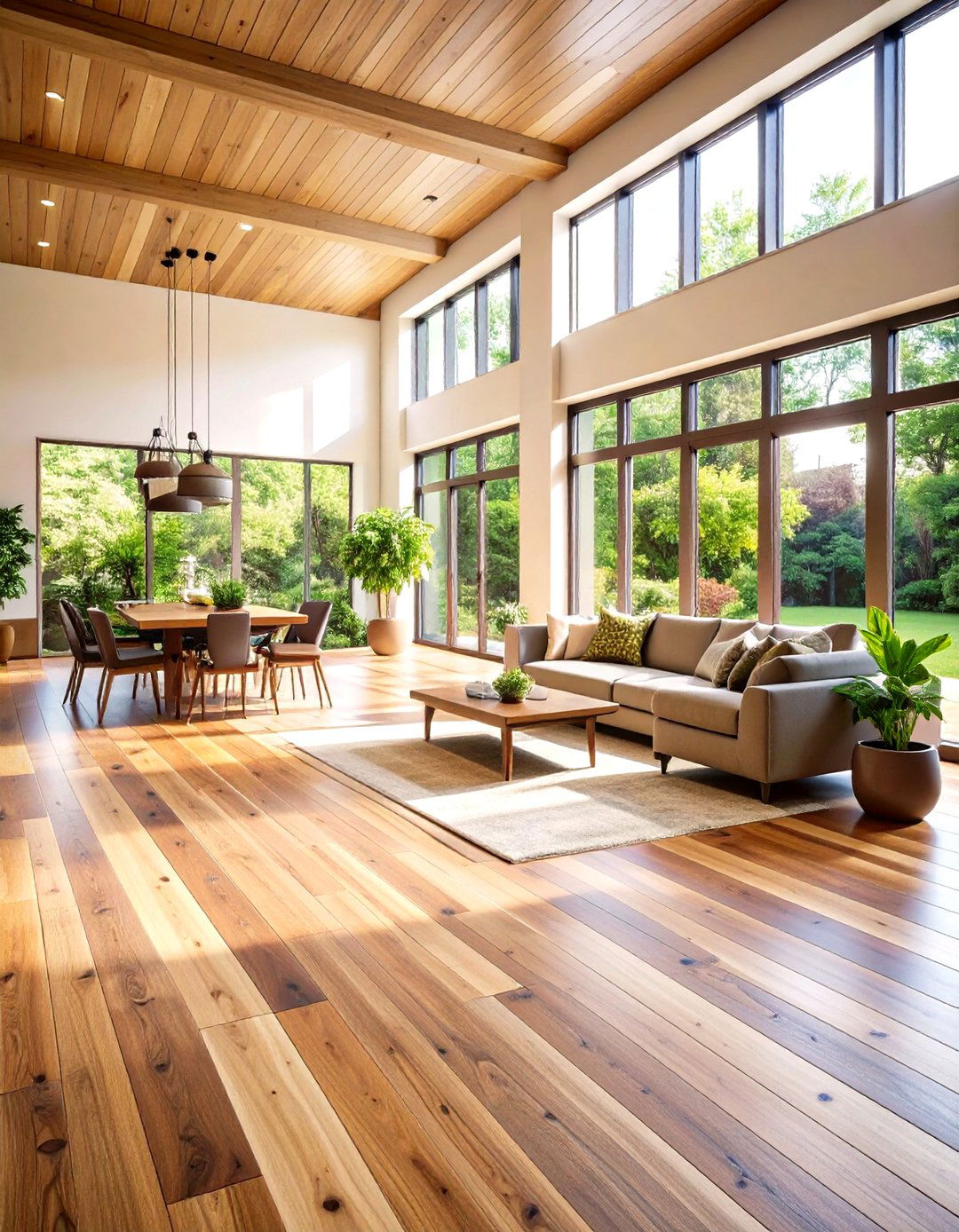
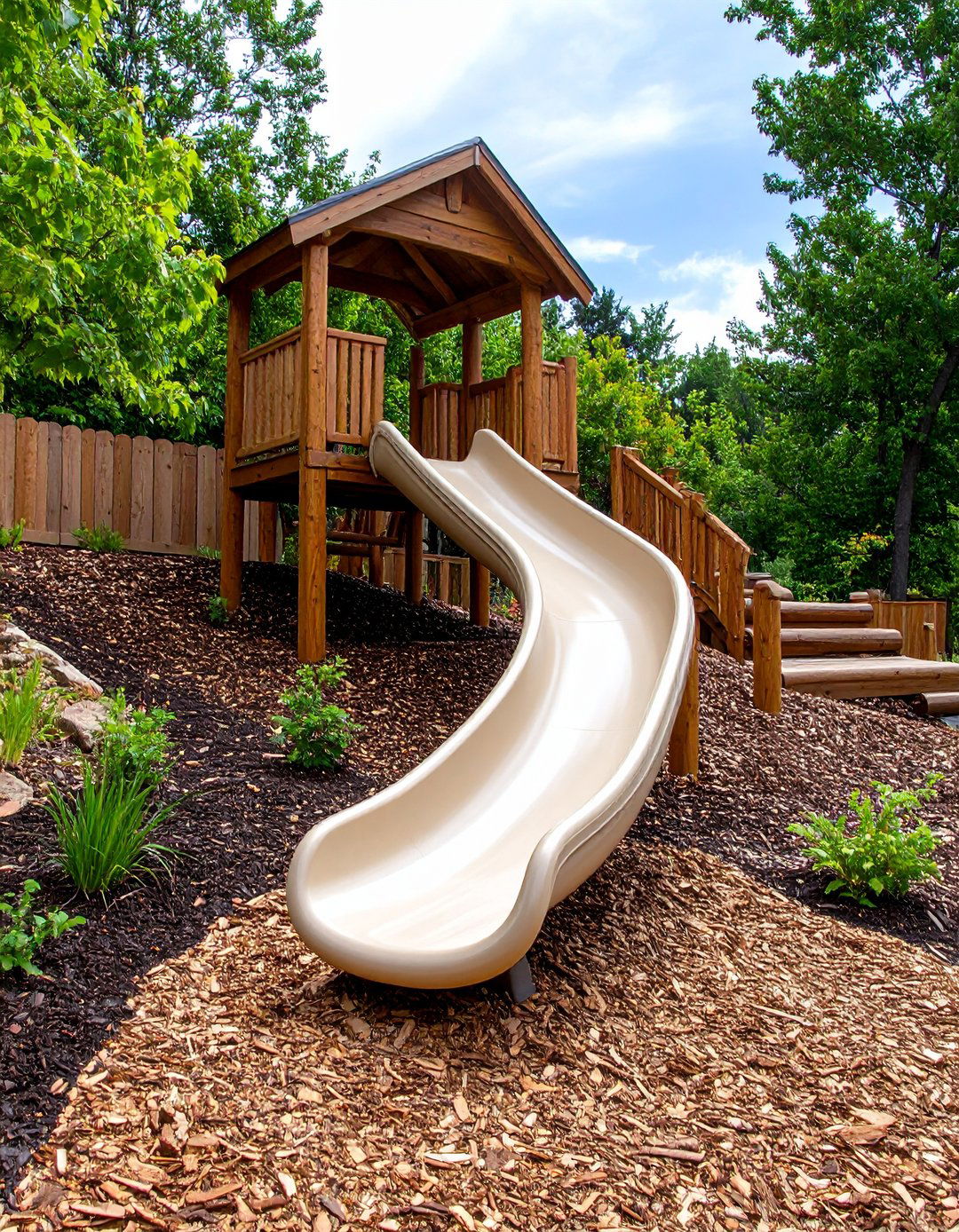
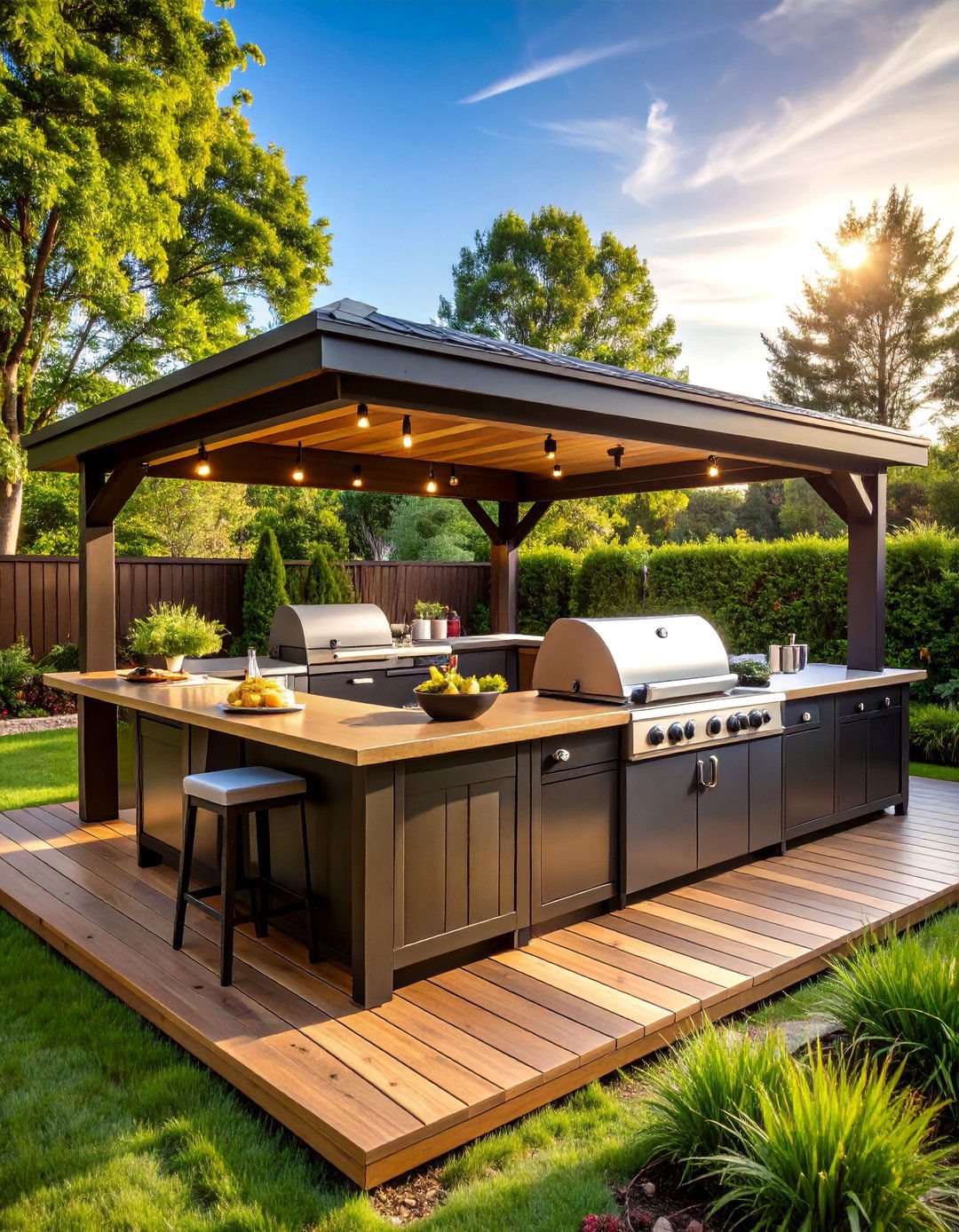
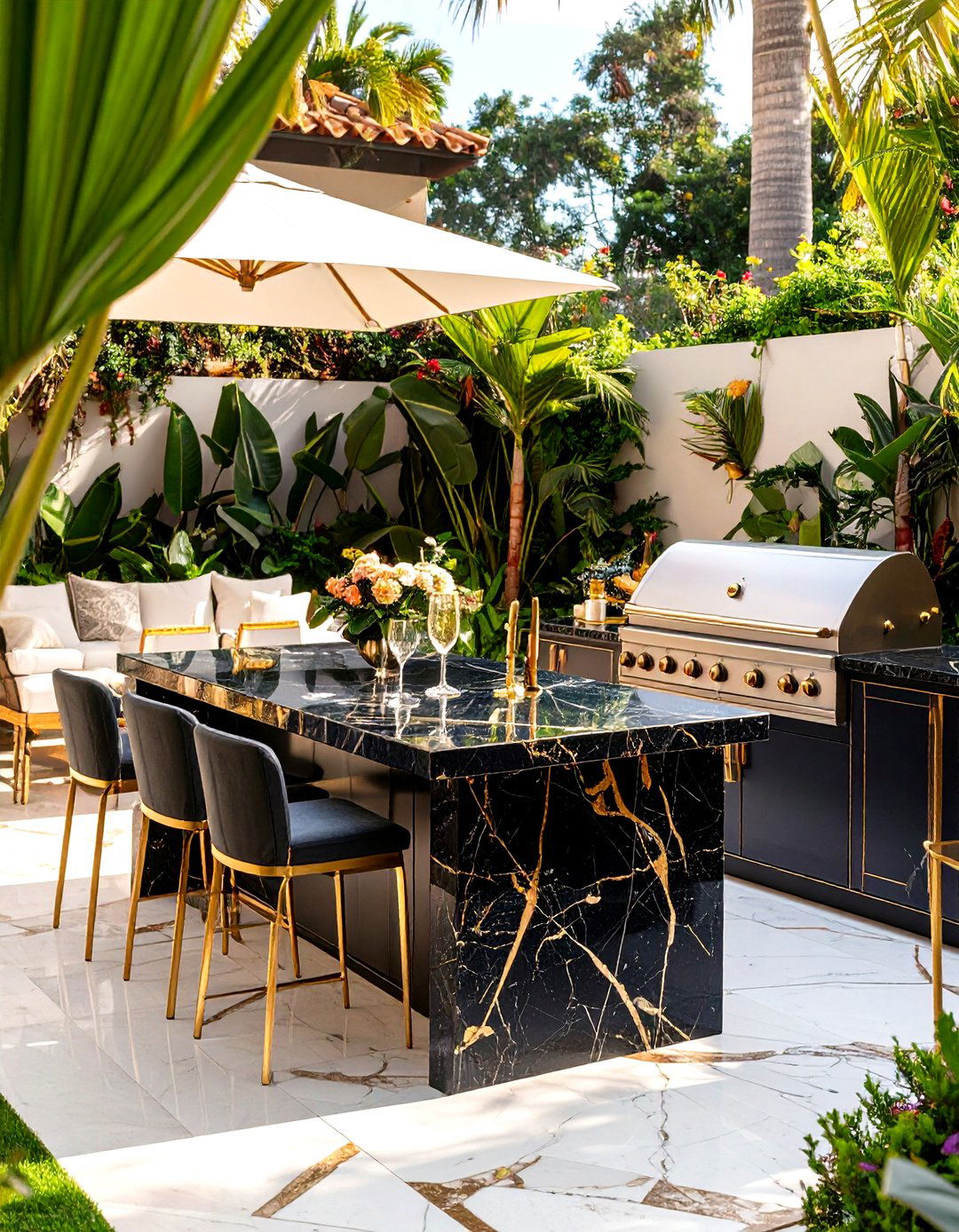

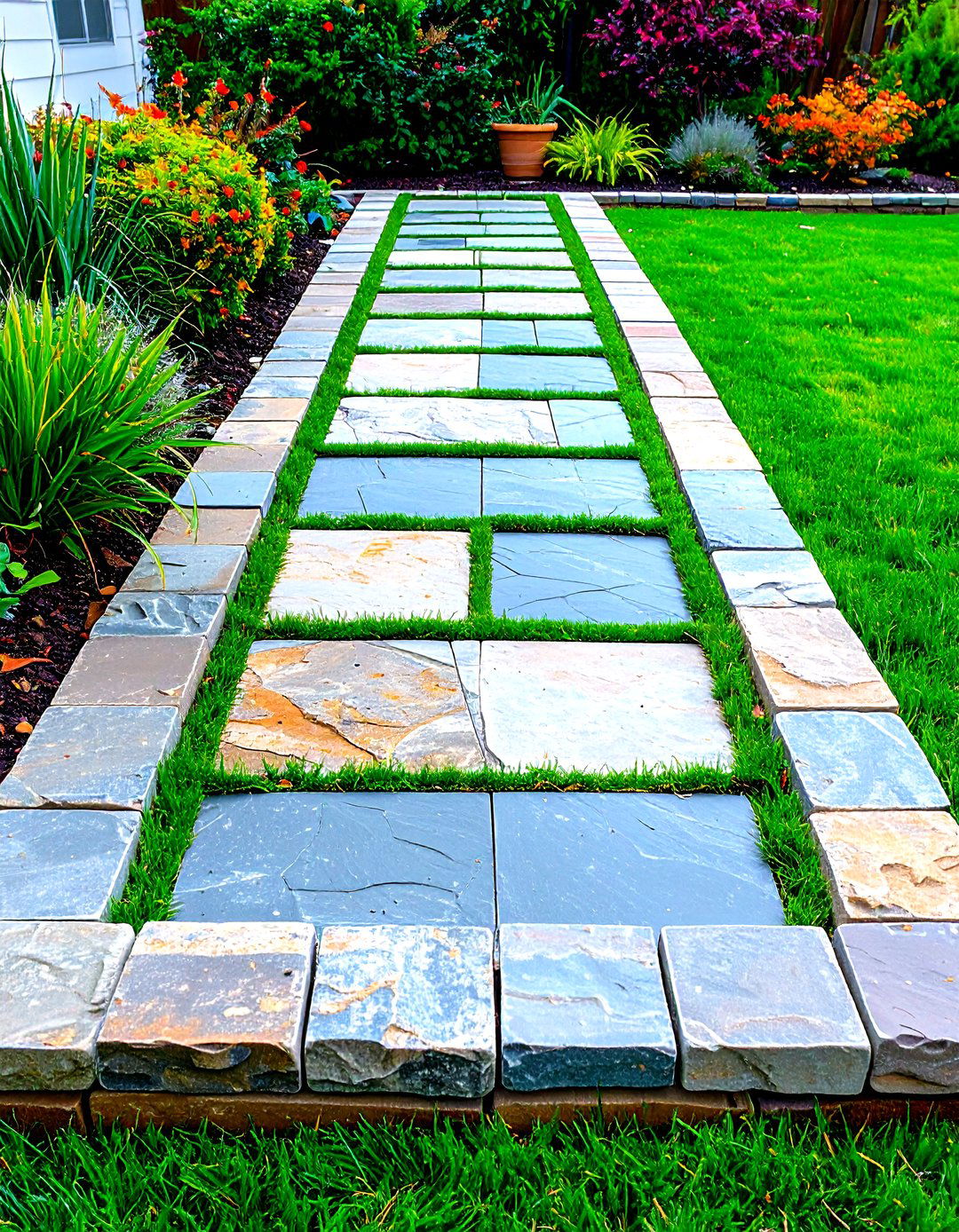
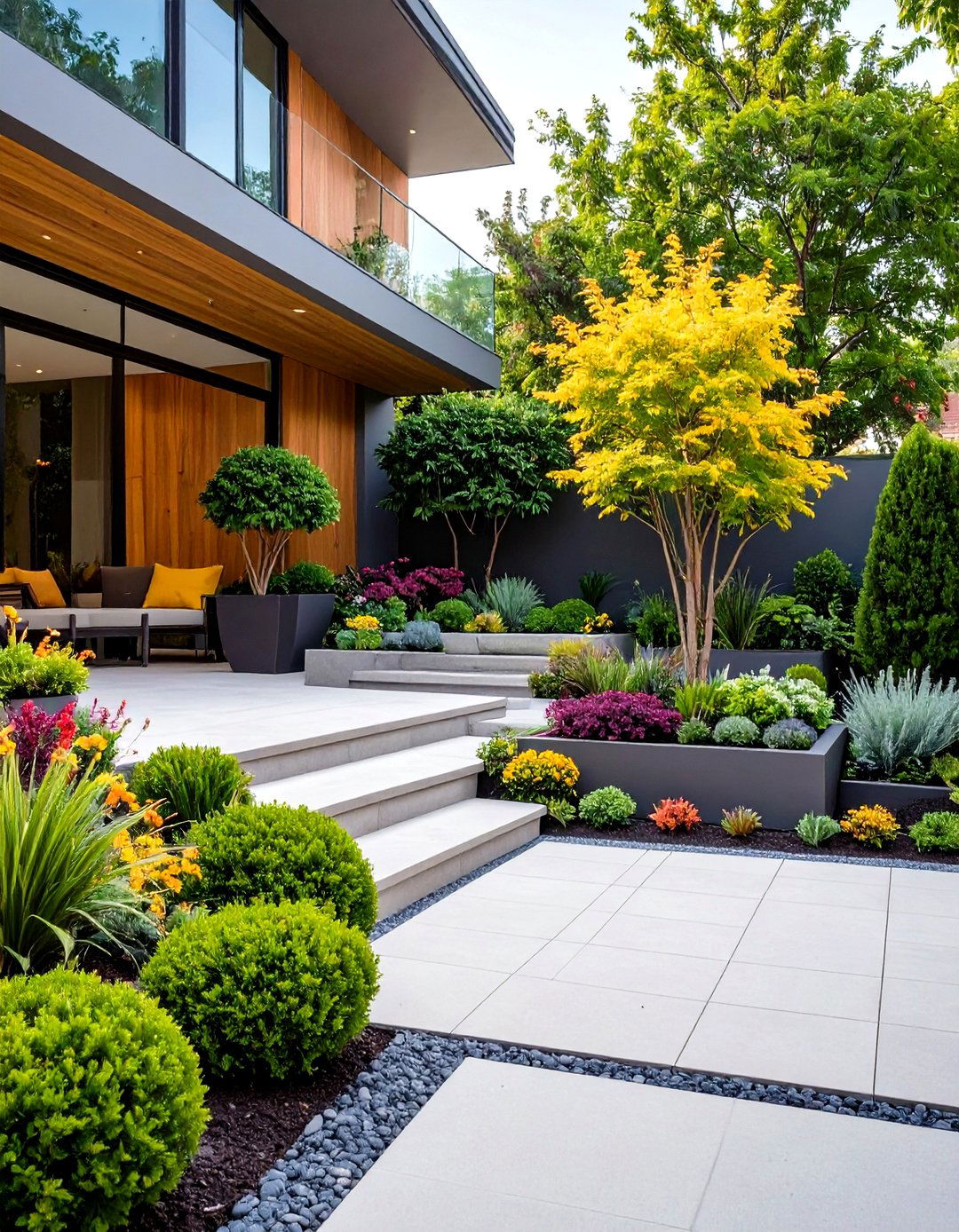
Leave a Reply